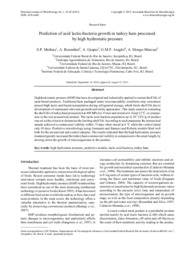Prediction of acid lactic-bacteria growth in turkey ham processed by high hydrostatic pressure.
Prediction of acid lactic-bacteria growth in turkey ham processed by high hydrostatic pressure.
Author(s): MATHIAS, S. P.; ROSENTHAL, A.; GASPAR, A.; ARAGÃO, G. M. F.; SLONGO-MARCUSI, A.
Summary: High hydrostatic pressure (HHP) has been investigated and industrially applied to extend shelf life of meat-based products. Traditional ham packaged under microaerophilic conditions may sometimes present high lactic acid bacteria population during refrigerated storage, which limits shelf life due to development of unpleasant odor and greenish and sticky appearance. This study aimed at evaluating the shelf life of turkey ham pressurized at 400 MPa for 15 min and stored at 4, 8 and 12 °C, in comparison to the non pressurized product. The lactic acid bacteria population up to 107 CFU/g of product was set as the criteria to determine the limiting shelf life According to such parameter the pressurized sample achieved a commercial viability within 75 days when stored at 4 °C while the control lasted only 45 days. Predictive microbiology using Gompertz and Baranyi and Roberts models fitted well both for the pressurized and control samples. The results indicated that the high hydrostatic pressure treatment greatly increased the turkey ham commercial viability in comparison to the usual length, by slowing down the growth of microorganisms in the product.
Publication year: 2013
Types of publication: Journal article
Unit: Embrapa Food Technology
Observation
Some of Embrapa's publications are published as ePub files. To read them, use or download one of the following free software options to your computer or mobile device. Android: Google Play Books; IOS: iBooks; Windows and Linux: Calibre.
Access other publications
Access the Agricultural Research Database (BDPA) to consult Embrapa's full library collection and records.
Visit Embrapa Bookstore to purchase books and other publications sold by Embrapa.

